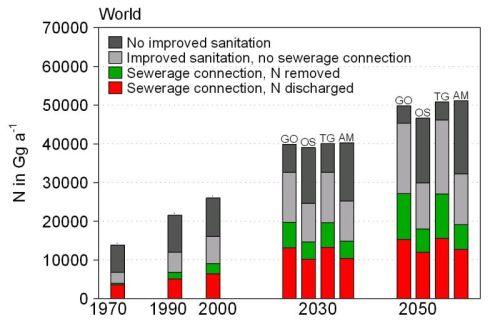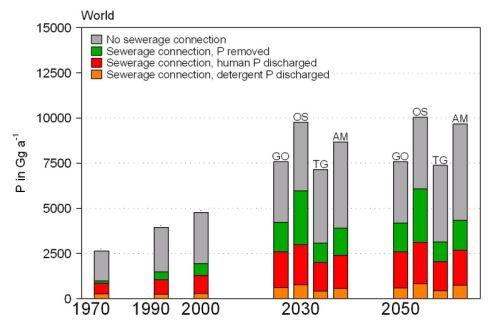Global nitrogen and phosphate in urban wastewater for the period 1970 to 2050
This paper constitutes the first spatially explicit, global assessment of sewage N and P emissions to surface water for the period 1970 to 2000, and the first projection of such N and P emissions for the future. This approach was developed as part of an international interdisciplinary effort to model river export of multiple bioactive elements (C, N, P) and their elemental forms (dissolved/particulate, inorganic/organic), by the Global Nutrient Export from Watersheds (Global NEWS) work group of the UNESCO Intergovernmental Oceanographic Commission (IOC). Global NEWS is a project under LOICZ.
Increasing river loads of N and P
In the past 4 to 5 decades, there have been important changes in sewage N and P emissions to surface water in many countries. N emissions from sewage have changed because of increasing population, economic growth leading to changes in diet, urbanization, and construction of sewerage and wastewater treatment systems.
Sewage effluent
P emissions from sewage have changed for the same reasons, but also because of changes in patterns of use of P-based detergents in laundry washing machines and dishwashing machines. P-free detergents based on zeolites were introduced in Europe in the mid-1980s and progressively replaced the detergents that were based on sodium tripolyphosphate (Na5P3O10) (STPP) through to the mid-1990s, when the markets stabilized. At present, P-free detergents based on zeolites make up 80 to 100% of all laundry detergent used in northern and western Europe. However, at the same time, the use of automatic dishwashers is increasing in European households, and no restrictions have yet been placed on the use of P-based detergents for these appliances.
For these reasons, major increases in sewage N and P inputs to surface waters have occurred between 1970 and 2000, globally and in all world regions discussed, except for North Asia, Europe, and Oceania.


Millennium Ecosystem Assesssment scenarios
Future continued population and economic growth in developing countries will almost certainly lead to further increasing sewage N and P emissions in the coming decades. With increasing numbers of households being connected to sewerage systems and the lagging installation of wastewater treatment systems, this may lead to severe eutrophication. Future estimates are implementations of the four Millennium Ecosystem Assessment scenarios, i.e. Global Orchestration (GO), Order from Strength (OS), Technogarden (TG) and Adapting Mosaic (AM).
GO portrays a globally connected society that focuses on global trade and economic liberalization and takes a reactive approach to ecosystem problems, but also takes strong steps to reduce poverty and inequality and to invest in public goods, such as infrastructure and education. In contrast, OS is a regionalized and fragmented world, concerned with security and protection, with the emphasis primarily on regional markets, paying little attention to public goods, and taking a reactive approach to ecosystem problems. TG is a globally connected world. relying strongly on environmentally sound technology, using highly managed, often engineered, ecosystems to deliver ecosystem services, and taking a proactive approach to the management of ecosystems in an effort to avoid problems. In AM, the fourth scenario, regional watershed-scale ecosystems are the focus of political and economic activity. Local institutions are strengthened and local ecosystem management strategies are common; societies develop a strongly proactive approach to the management of ecosystems based on simple technologies. The major drivers relevant to land use and agriculture are discussed below.
Scenarios for sewage effluent
Using country-specific projections for population and economic growth, urbanization, development of sewage systems and wastewater treatment installations, a rapid increase in global sewage emissions is predicted, from 6.4 Tg of N and 1.3 Tg of P per year in 2000 to 12.0-15.5 Tg of N and 2.4-3.1 Tg of P per year in 2050.
While North America (strong increase), Oceania (moderate increase), Europe (decrease) and North Asia (decrease) show contrasting developments, in the developing countries sewage N and P discharge will likely increase by a factor of 2.5 to 3.5 between 2000 and 2050 (Figure xx). This is a combined effect of increasing population, urbanization and development of sewage systems. Even in optimistic scenarios for the development of wastewater treatment systems global N and P flows are not likely to decline.
Data
- Download the data and results (ZIP, 555KB) of this analysis
Authors
Specifications
- Publication title
- Global nitrogen and phosphate in urban wastewater for the period 1970 to 2050
- Publication date
- 11 September 2009
- Publication type
- Publication
- Magazine
- Global Biogeochemical Cycles, 23, GB0A03
- Product number
- 92395




